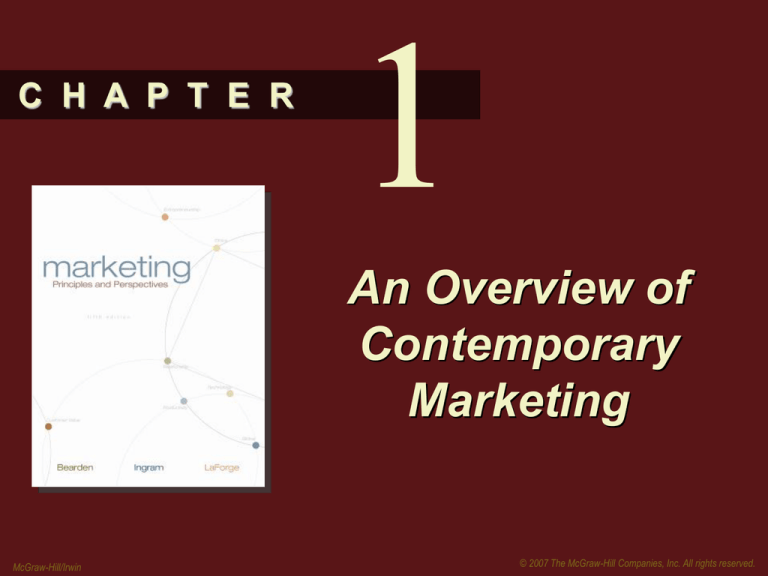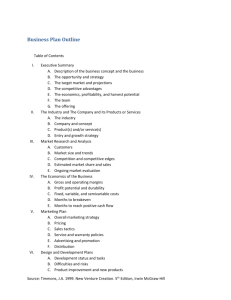
C H A P T E R
1
An Overview of
Contemporary
Marketing
McGraw-Hill/Irwin
© 2007 The McGraw-Hill Companies, Inc. All rights reserved.
Learning Objectives
After studying this chapter, you should be able to:
Discuss what marketing is and why it is important to
organizations and individuals.
Distinguish between marketing as an organizational
philosophy and a societal process.
Understand the components of a marketing strategy and
the different activities involved in marketing products and
services.
Be aware of the various types of marketing institutions
and the different marketing positions available in these
institutions.
Understand the basic elements and relationships in the
contemporary marketing framework.
Bearden Marketing 5th Ed
1-2
© 2007 The McGraw-Hill Companies, Inc. All rights reserved.
Amazon: An Entrepreneurial Story
Amazon.com represents an
interesting entrepreneurial story.
Jeff Bezos started Amazon.com as
a book retailer in 1995.
The company’s mission was to use
the Internet to transform book
buying into the fastest, easiest,
and most enjoyable shopping
experience available.
Sales have increased from about
$150 million in 1997 to over $7
billion today.
Bearden Marketing 5th Ed
1-3
© 2007 The McGraw-Hill Companies, Inc. All rights reserved.
Amazon and Marketing
The Amazon.com story
illustrates a basic principle of
successful marketing:
Identify market opportunities
and respond by developing and
executing marketing strategies
to take advantage of the
opportunities better than
competitors do.
Bearden Marketing 5th Ed
1-4
© 2007 The McGraw-Hill Companies, Inc. All rights reserved.
Marketing - Definition
What is marketing?
Marketing is an organizational function and a
set of processes for creating, communicating,
and delivering value to customers and for
managing customer relationships in ways that
benefit the organization and its stakeholders.
- American Marketing Association
www.marketingpower.com
Bearden Marketing 5th Ed
1-5
© 2007 The McGraw-Hill Companies, Inc. All rights reserved.
Why is marketing important?
Marketing is important to
many organizations.
For example, the Humane
Society uses advertising to
promote animal protection.
Bearden Marketing 5th Ed
1-6
© 2007 The McGraw-Hill Companies, Inc. All rights reserved.
The Importance of Marketing
Social
Entrepreneurs
Individuals
Different Types
of Organizations
Small Firms
Bearden Marketing 5th Ed
Farmers
Nonprofit
1-7
© 2007 The McGraw-Hill Companies, Inc. All rights reserved.
Views of Marketing
Production
Philosophy
Marketing as
an Organizational
Philosophy
Selling
Philosophy
Marketing
Philosophy
Bearden Marketing 5th Ed
1-8
© 2007 The McGraw-Hill Companies, Inc. All rights reserved.
Marketing as an Organizational Philosophy
Production
Philosophy
A production philosophy exists
when an organization emphasizes
the production function.
Selling
Philosophy
A selling philosophy
predominates where the selling
function is most valued.
Marketing
Philosophy
A marketing philosophy
suggests that the organization
focuses on satisfying the needs
of customers.
Bearden Marketing 5th Ed
1-9
© 2007 The McGraw-Hill Companies, Inc. All rights reserved.
Practicing the Marketing Concept
Marketing as an organizational philosophy has
been based on the marketing concept. This
concept consists of three interrelated principles:
An organization’s basic purpose is to satisfy customer
needs.
Satisfying customer needs requires integrated,
coordinated efforts throughout the organization.
Organizations should focus on long-term success.
Bearden Marketing 5th Ed
1-10
© 2007 The McGraw-Hill Companies, Inc. All rights reserved.
Developing a Market Orientation
A market orientation consists of creating norms
and values that encourage customer-oriented
behavior throughout the organization, including:
Generating
Market
Intelligence
Bearden Marketing 5th Ed
Disseminating
Market
Intelligence
1-11
Responding to
Market
Intelligence
© 2007 The McGraw-Hill Companies, Inc. All rights reserved.
Customer Equity
Customer equity is the financial value of a firm’s
customer relationships. It consists of profits from firsttime customers plus expected profits from future sales to
these and other customers. Customer equity can be
increased in several ways:
Acquire more profitable customers at a lower cost.
Retain profitable customers longer.
Win back profitable customers.
Eliminate unprofitable customers.
Sell more to profitable customers.
Reduce service and operational costs.
Bearden Marketing 5th Ed
1-12
© 2007 The McGraw-Hill Companies, Inc. All rights reserved.
Customer Equity Relationships
Marketing
Concept,
market
Orientation,
CRM
Providing
exceptional
customer
value
Achieving
completely
satisfied
customers
Earning
high
customer
loyalty
Increasing
sales growth
and
profits
Building
customer
equity
1-13
© 2007 The McGraw-Hill Companies, Inc. All rights reserved.
Bearden Marketing 5th Ed
Marketing as a Societal Process
Defined as a process that facilitates the flow of goods
and services from producers to consumers in a society.
Producers of
Goods & Services
Consumers of
Goods & Services
Emphasis on:
Institution involved
Activities performed
Effectiveness of system
Efficiency of system
Bearden Marketing 5th Ed
1-14
© 2007 The McGraw-Hill Companies, Inc. All rights reserved.
Thinking Critically
1
Identify the most important benefits of the
societal marketing system in the United States.
2
What changes would you recommend for this
system to be more beneficial to U.S. society?
3
Identify the most negative effects of the societal
marketing system in the United States.
4
What changes would you recommend to reduce
these negative effects?
Bearden Marketing 5th Ed
1-15
© 2007 The McGraw-Hill Companies, Inc. All rights reserved.
Marketing as a Set of Processes
Marketing
Exchanges
Marketing
Institutions
Marketing
Processes
Marketing
Positions
Bearden Marketing 5th Ed
Marketing
Strategies
Marketing
Activities
1-16
© 2007 The McGraw-Hill Companies, Inc. All rights reserved.
Marketing Exchanges
Exchange is defined as the transfer of something
tangible or intangible, actual or symbolic, between two or
more social actors.
Bearden Marketing 5th Ed
1-17
© 2007 The McGraw-Hill Companies, Inc. All rights reserved.
Marketing Strategies
Marketing strategies consist of selecting a target
market and developing a marketing mix to
satisfy that market’s needs.
A target market is a defined group of consumers or
organizations with which a firm wants to create marketing
exchanges and relationships.
A marketing mix is the overall marketing offer to appeal to
the target market.
Bearden Marketing 5th Ed
1-18
© 2007 The McGraw-Hill Companies, Inc. All rights reserved.
Marketing Mix Decisions
Bearden Marketing 5th Ed
1-19
© 2007 The McGraw-Hill Companies, Inc. All rights reserved.
Marketing Strategies
The cosmetics industry is a good place to look
for examples of different marketing strategies.
Bearden Marketing 5th Ed
1-20
© 2007 The McGraw-Hill Companies, Inc. All rights reserved.
Marketing Activities
Bearden Marketing 5th Ed
1-21
© 2007 The McGraw-Hill Companies, Inc. All rights reserved.
Marketing Positions
Marketing
manager
Directs all company’s marketing
activities, including planning, organizing,
staffing, directing, controlling, evaluating
performance
Product
manager
Develops goals, objectives, plans,
strategies, marketing mixes for product
line or brand
more
Bearden Marketing 5th Ed
1-22
© 2007 The McGraw-Hill Companies, Inc. All rights reserved.
Marketing Positions (con’t)
Advertising
manager
Devises advertising policy and strategy,
selects advertising agencies, develops
promotional campaigns, selects media,
allocates advertising expenditures
Supply chain
manager
Manages distribution system, including
storage and transportation for all
products and services
more
Bearden Marketing 5th Ed
1-23
© 2007 The McGraw-Hill Companies, Inc. All rights reserved.
Marketing Positions (con’t)
Purchasing
manager
Manages all purchasing activities,
including buying product ingredients or
components, supplies, equipment,
needed materials
Marketing
research
manager
Develops research designs for specific
problems; collects, analyzes, interprets
data; presents results to top
management
more
Bearden Marketing 5th Ed
1-24
© 2007 The McGraw-Hill Companies, Inc. All rights reserved.
Marketing Positions (con’t)
Public
relations
manager
Manages all communications with media
and company stakeholders
to present favorable public image
Customer
service
manager
Provides customer service, handles
customer complaints
Sales
manager
Organizes, develops, directs, controls,
evaluates sales force
Bearden Marketing 5th Ed
1-25
© 2007 The McGraw-Hill Companies, Inc. All rights reserved.
Marketing Institutions
Retailers
Wholesalers
Marketing
research firms
Advertising
agencies
Bearden Marketing 5th Ed
1-26
© 2007 The McGraw-Hill Companies, Inc. All rights reserved.
Marketing Environment
Exhibit 1-9
Bearden Marketing 5th Ed
1-27
© 2007 The McGraw-Hill Companies, Inc. All rights reserved.
Key Marketing Perceptive
Global
Relationship
Viewing the world as the potential
marketplace to include identifying and
responding both to market opportunities
around the world and to different cultural
groups within each market.
Building partnerships with firms outside the
organization and encouraging teamwork
among different functions within the
organization to develop long-term customer
relationships.
more
Bearden Marketing 5th Ed
1-28
© 2007 The McGraw-Hill Companies, Inc. All rights reserved.
Key Marketing Perceptive (con’t)
Ethics
Customer
value
Productivity
Addressing the morality of marketing
decisions and practicing social
responsibility to include ecological
considerations.
Constantly looking for ways to give customers
more for less.
Trying to get the best return for each
marketing dollar spent.
more
Bearden Marketing 5th Ed
1-29
© 2007 The McGraw-Hill Companies, Inc. All rights reserved.
Key Marketing Perceptive (con’t)
Technology
Translating new and emerging technologies
into successful products and services, and
using technology to improve marketing
practice.
Entrepreneur- Focusing on innovation, on risk taking, and
on being proactive in marketing efforts.
ship
Bearden Marketing 5th Ed
1-30
© 2007 The McGraw-Hill Companies, Inc. All rights reserved.
Summary
After studying this chapter, you should be able to:
Discuss what marketing is and why it is important to
organizations and individuals.
Distinguish between marketing as an organizational
philosophy and a societal process.
Understand the components of a marketing strategy
and the different activities involved in marketing
products and services.
Be aware of the various types of marketing
institutions and the different marketing positions
available in these institutions.
Understand the basic elements and relationships in
the contemporary marketing framework.
Bearden Marketing 5th Ed
1-31
© 2007 The McGraw-Hill Companies, Inc. All rights reserved.








